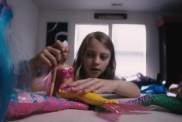
The problem with Step Up Revolution are all the parts that involve words. For example, when one character in the film is talking to another, and busts out with some solid advice such as, “Do a few more mobs, get the hits, and we’ll get the money!” the movie completely falls apart. Now then, as I read that quote back, I realize I should provide some context; it clearly makes no sense out there by its lonesome. So let’s get right into it, beginning with the plot behind Step Up Revolution.
The main thrust of the story here is that “The Mob,” a Miami dance crew, is performing flash mobs to win a YouTube contest. They need to get 10 million hits to win $100,000. By my estimation there are about 12 people involved with each production, meaning, after taxes, each dance crew member would clear a solid $4k, enough for a down payment on a mid-size sedan. I suppose we’re also fortunate the group didn’t call themselves “The Hot Dog Eatin’ Contest Winners” or else the film would have taken an entirely different direction. Regardless, know in your heart that “The Mob” goes around flash mobbin’ for the clicks. This will be repeated by various main characters a half a dozen times should you find yourself lost as to why anyone is doing anything. Remember YouTube? The Clicks? The money? That’s why we’re here … at least until Ryan Atwood’s dad from The O.C. (Peter Gallagher) intercedes and gives us a legit villain to root against, and one with massive eyebrows thrown in for good measure!
Another quick aside for everyone to chime in on – why do they keep switching out the nondescript brunettes for this series? Jenna Dewan was Step Up‘s main gal (she went on to marry Channing Tatum), but she was replaced by Briana Evigan in the delightfully named Step Up 2 The Streets. Alyson Stoner was our 3-D heroine in Step Up 3-D, while this time around Kathryn McCormick takes the reins as Emily, the rich girl from Cleveland, OH. “Well,” I can hear you saying, “These films are in different settings, so they need a different lead each time.” But then explain “the Moose conundrum”!? He (Adam G. Sevani) appears in three out of four films, as the same person, creating a through line that should have been maintained via a lead.
Look, if they were casting Olivia Munn, or Rose Byrne, or people everyone was aware of, and said people got too expensive, well then I could see making a switch. But why do we need to connect with an entirely new lead charter set-up each time? Why must each Step Up exist as though the world of dancing with a crew has just been discovered? It’s downright jarring, I tell ya, to have to wonder “well where did they get this gal, who looks much like (but not exactly) like the previous actor who played in Step Up? For the record, Kathryn is from the television show So You Think You Can Dance? and she’s not half bad in this performance. Sure, the dialogue completely fails her, and the story is preposterous, but I don’t hold her accountable for larger story issues.
So, where were we? Ah yes, “The Mob” is hoping to go viral with their inspired flash mobs, and it must be said these routines are a thing of beauty. For the 30 minutes of dancing, the film flat-out works, though only because there’s no story or conversations to worry about. Sadly, the story isn’t all about the “hits” because hotel magnate Mr. Anderson (Peter Gallagher) decides to build a luxury hotel smack dab in the middle of the neighborhood where “The Mob” lays their domes. All of a sudden “the clicks” aren’t so important, what with all the rampant corruption and luxury hotels being built and so forth. “The Mob” now has a larger goal, and that goal must be accomplished via dance. Would dance work against a corporate power? It definitely plays as silly throughout Step Up Revolution though I do like to imagine a world where serious problems are solved via theatricality.
Sadly, it is during the third act where Step Up Revolution truly starts to turn awful. The almighty chase for the clicks, while silly on the surface, at least seemed realistic. The faux quest to show The Miami City Council what’s up via dance comes off as an extremely one-note joke. There’s also relationship drama thrown in, because otherwise how would you have that scene where the problems are cleared up, all at once, via dance? You wouldn’t! So naturally there needs to be a love angle, even if it weighs the story down unnecessarily. Which it does. All of these little problems add up, the story momentum, the dialogue, the forced relationships, dooming Step Up Revolution.
The good part about Step Up Revolution? The dancing! And that’s about it, that’s the list. So which holds sway? What moments will stay in your mind the longest, eventually forming your overall opinion of the film? Unfortunately, it’s “everything else that didn’t involve dancing”. Which is a shame, because dance movies have a noble tradition in our culture. But Step Up Revolution? Nope, it’s a “pass,” not a revolution at all, it’s actually much more of a step back.









